Fiber optic cable has become a standard component in most modern cable infrastructures. Its resistance to electromagnetic and radio frequency interference has made it one of the best for signal transmission. It is capable of transporting signals over considerable distances on most networks. Currently, fiber optic cable used on many residential streets and leads directly to houses. However, for many people, the very meaning of fiber, how it works and is still not very clear. In this article, we'll go over the answers to some of the most common questions about , help you choose one, and tell you when and how it should be used.
What is optical fiber?
Optical fiber, or optical glass, is essentially very thin threads of glass through which the light impulse is transmitted. Glass with a thin jacket is called a shell, a signal passes through it. These fiber optic strands are assembled together in a common jacket to form a cable. If you try to stretch the fiber strands during installation, you will most likely damage them. In some cable structures, you can see a solid core of composite materials to give additional protection. To transmit a signal through glass filaments, electrical devices called optical transmitters convert electrical signals (electrons) into pulses of light (photons). The pulses are modulated so that the receiving end can interpret the received signal from the transmitting end. Once the signal is received, it is converted back from photons to electrons and then transmitted to the network. Usually an optical channel is required two fiber filaments, one for sending and one for receiving.
There are two types of optical fiber, multimode and single mode.
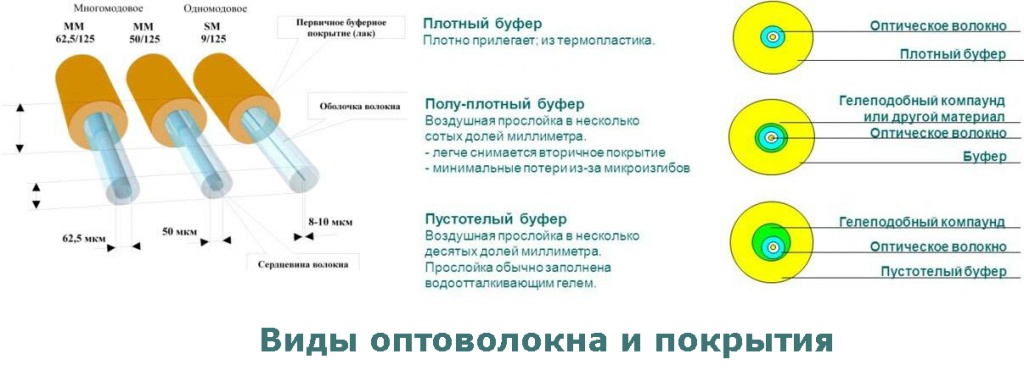
Multimode fiber allows the signal to pass in several modes along the inner surface of the glass thread or rod. The core of the fiber is available in diameters of 62.5 and 50 microns. A micrometer is 1 millionth of a metre. For comparison, human hair is about 100 microns in diameter. In multimode fiber, light is generated from an inexpensive light source, a light emitting diode. Digital watches use a similar technology. This LED-based optical transmitter is commonly referred to as a media converter. As the signal from the converter travels through the glass, it bounces back and forth along the inner wall of the shell until it reaches its destination. This process takes place in millions per second and provides data transfer rates of 10 Mbps or 100 Mbps. Slower LEDs are almost out of use now as the demand for large data bandwidth has increased. In order to achieve a higher data rate, the market has created a vertical cavity surface emitting laser. The VCSEL focuses the light into a narrower band in the glass and operates at higher speeds. The technology allows you to increase the transmission speed to 1 Gb / s and 10 Gb / s at low cost, using the appropriate fiber. The specially designed glass works better at higher data rates and allows signals to travel farther. For example, the best 50 µm fiber can accommodate 10 Gbps at distances up to 550 meters. single mode optical fiber usually has a core, 8.3 µm in diameter. Single-mode fiber requires laser technology to transmit and receive data. Although a laser is used, the light in a single-mode fiber is refracted from the fiber cladding. Single mode has the ability to transmit a signal for many kilometers, making it ideal for phone and cable television. The electronics required to transmit a single-mode signal are significantly more expensive than those for multi-mode, so they are not often used in local network. Although the basic dimensions of multimode and single-mode fiber are different, both types of fibers have an outer diameter of about 250 µm. These cables are easier to work with.
Where is fiber optic cable used?
Fiber optic cables can carry more data over vast distances than conventional copper cables. Fiber used for communication networks buildings together, for example, linking a dormitory and a building on a university campus, and today they are used by a large number of residential consumers of television and telephone services. In most commercial buildings, fiber is used to connect the fixed MDF frame, where network servers are typically found, and telecom cabinets. For example, a small group of users may be located 500 meters from the MDF. An example, in fact, is the connection of all your computers to a network. So, standard communications are limited to 100 meters, they simply will not work at long distances. By placing network switches and including a media converter in the same housing, you can use fiber optic cable to cover those 100 meters. A data converter at the other end of the fiber optic cable completes the link. The fiber optic cable can be installed even in small spaces, as one optical cable can replace hundreds copper cables connections.
Which optical fiber to choose, 50 microns or 62.5 microns?
Although 62.5 micron fiber was at its peak only a few years ago, 50 micron has quickly gained significant market share. 50um fiber can have 20 times greater throughput(data bandwidth) than 62.5 microns. For identification purposes, multimode and singlemode fiber are often separated by both performance levels and specific ISO/IEC standards that depend on bandwidth. The 62.5 µm multimode fiber is referred to as OM1. 50 micron fiber is called OM2, OM3 and recently OM4 has also appeared. As you can imagine, OM4 has more bandwidth than OM3 and OM3 has more bandwidth than OM2. Fifty micron OM3 fiber is rated for 10 Gbps of bandwidth up to 300 meters, while OM4 can transmit up to 550 meters. Thus, many users now prefer OM3 and OM4 over other glass types. Almost 80% of the 50 µm fiber is OM3 or OM4 fiber. If you need higher data rates or have a network upgrade plan, I recommend choosing OM3 or OM4.
What types of connectors should be used?

There are LC, FC, MT-RJ, ST and SC connectors. There are also MT/MTP types that can hold up to 12 strands of fiber and take up much less space than other connectors. Most Popular - ConnectorsSC type, also known as connectors general purpose to press and turn to lock. Manufacturers prefer SC and ST connectors.
Which cable design to choose?
There are numerous designs of optical cables and almost any of them have a unique design. Closed or open cable with rigid buffer fibers is very popular if the installation requires the cable to leave the building for a short distance and then re-enter another enclosure. There are enclosed armored cables that can be used in industrial premises or places where the cable may be subjected to mechanical stress. This type of cable can save money because booking is an alternative metal pipe or plastic cable tunnel.
- As you can see, when choosing an appropriate fiber optic cable design, you must carefully analyze all the cable paths and determine how much protection the strands of fiber need, how you want to place them indoors, and how you intend to hide them.
Do you know how the Internet, telephony or digital television comes to the house from the most advanced Internet providers? After all, technology has stepped forward a long time ago and if we used to (and who still) connected to the World Wide Web through modems and later through hubs and twisted pair (ordinary wires), now a thin wire and the speed of light are enough to transfer data. This is surprising, because getting high-quality and fast Internet, we rarely think about how it was done.
Let's learn more about the mysterious PON technology, which is increasingly conquering the market for digital television, telephony and of course the Internet.
So what is behind the acronym? PON technology - passive optical networks. They are passive because no active equipment is used in the section from the exchange to the subscriber and no additional power supply is required, the fiber stretches to the client's apartment. Due to this, a high bandwidth of the channel is obtained and, consequently, the ability to connect several services via one telephone, television, Internet line.
It turns out that by going to a modern PBX, we can see an amazing picture, when literally tens of thousands of subscribers can be served from one rack. And all because the main advantage of PON is a glass optical fiber, which allows you to transfer data using not an electrical, but an optical signal (light). This signal, when passing from the communication center to the apartment, does not require additional equipment like switches or routers. The range of the optical signal is up to 20 km, which is several times greater than that of the electric signal.

The PON access node consists of three main elements: a frame (the place where the board and power supply are installed), a backbone card that connects to the network core, and line cards. Up to 64 subscribers can be connected to one line card port.
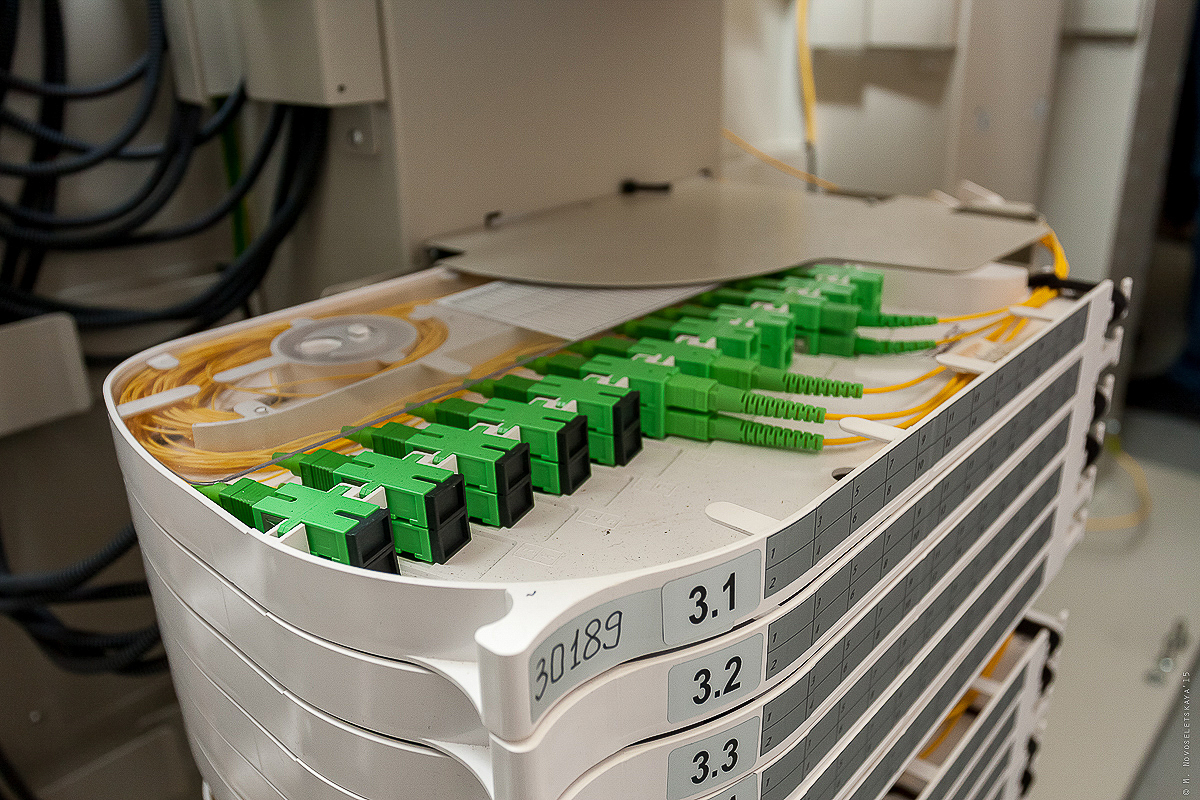
If you thought that the fiber optic is laid by a "solid wire" from the PBX to the apartment, then this is not so: the signal is divided in a certain section of the line. To divide the signal, a passive optical splitter was invented - a splitter that turns one fiber into two, four, eight, and so on. And before the Internet or interactive TV comes to the apartment, it goes through different stages.
As a rule, there is a distribution box in the basement, where the cable, consisting of 144 fibers, is divided into the amount that is needed in this particular front door (or house), while the rest is passed on. These manipulations are made by masters.
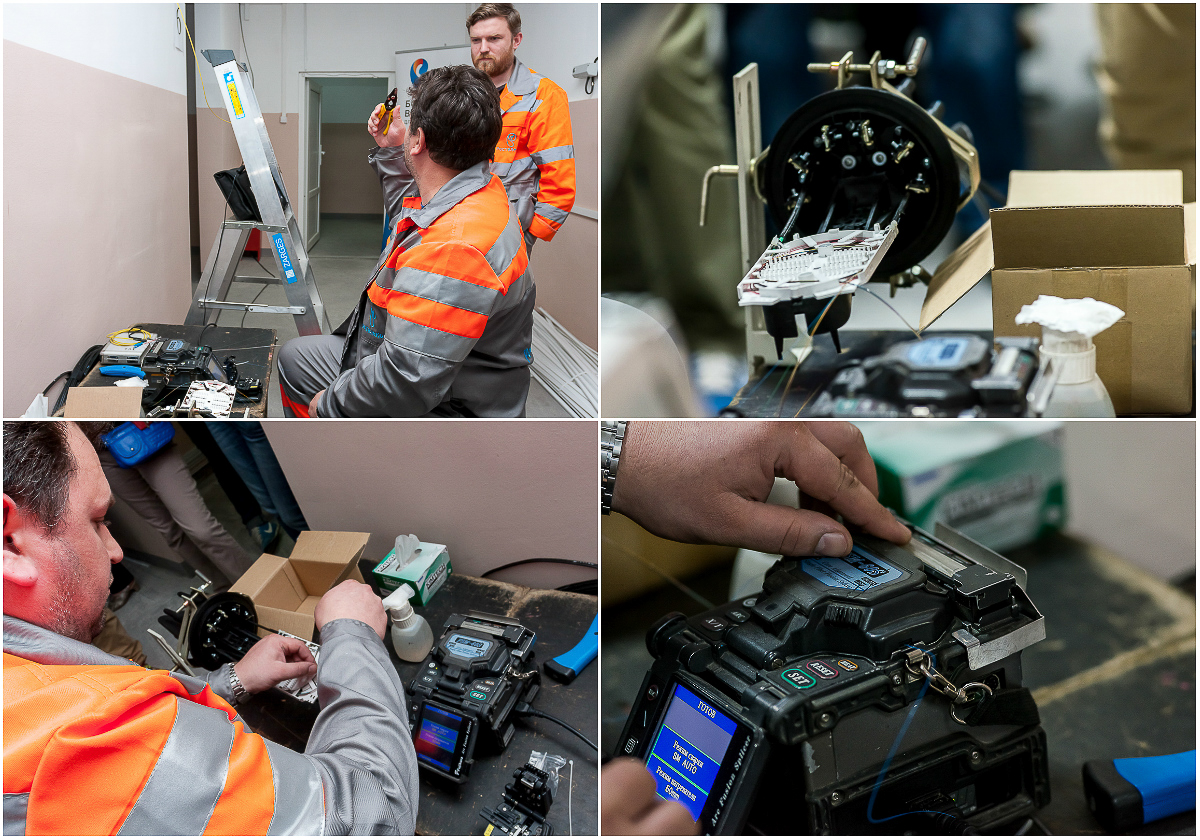
Fibers are laid in a bay, a cassette. Then a protective box is put on. All together - a clutch.
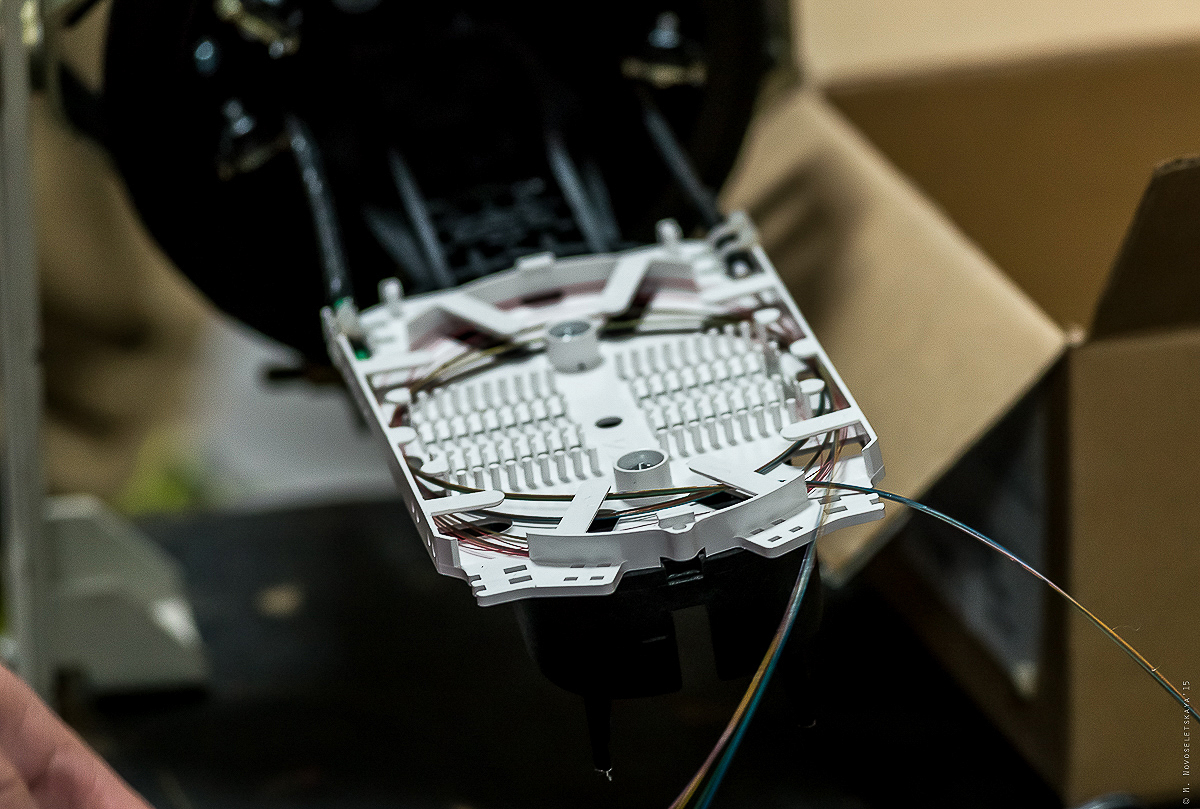
A device that is diagnostic for detecting fiber length, possible defects, etc. It must be used when installing the system.
![]()
From the basement and the coupling bay already known to us, the fibers enter the splitter, then into the distribution box, which in turn is located directly in the entrance and on the floor.
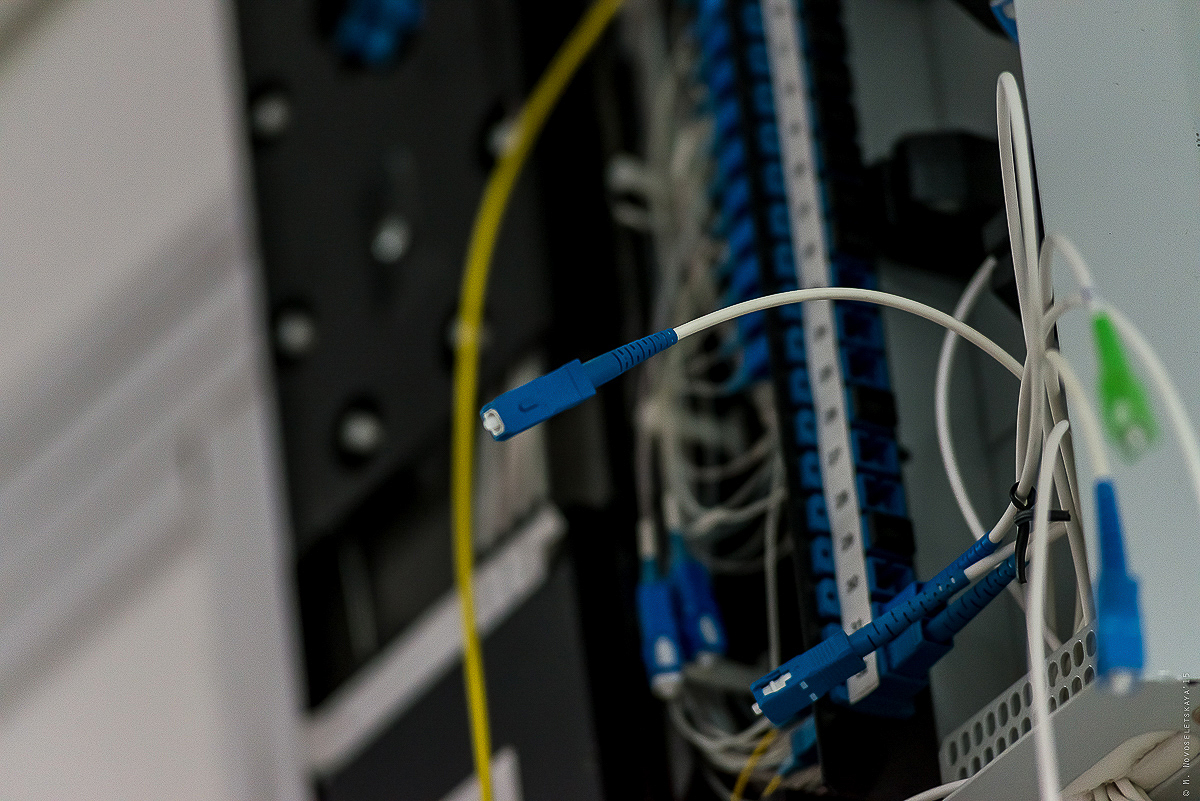
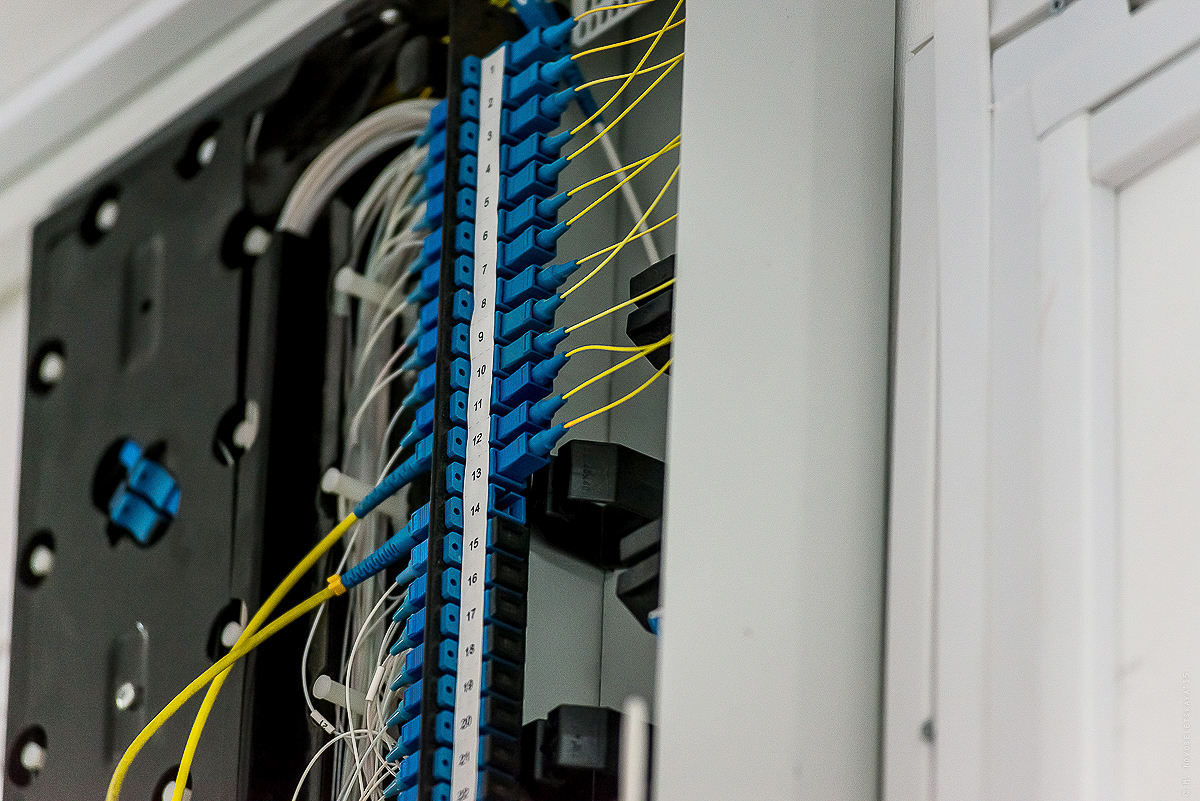
The optical patch cord from the subscriber's apartment to the junction box located in the entrance is placed in protective boxes.

After both ends of the fiber (from the splitter and from the apartment) are in junction box, they are connected using a special welding machine. The fiber is spliced in a coupler, a splitter and a box, and the subscriber's patch cord from the apartment is connected to the spliced port in the junction box. Thus, a completely fiber-optic line from the PBX to the subscriber is obtained.
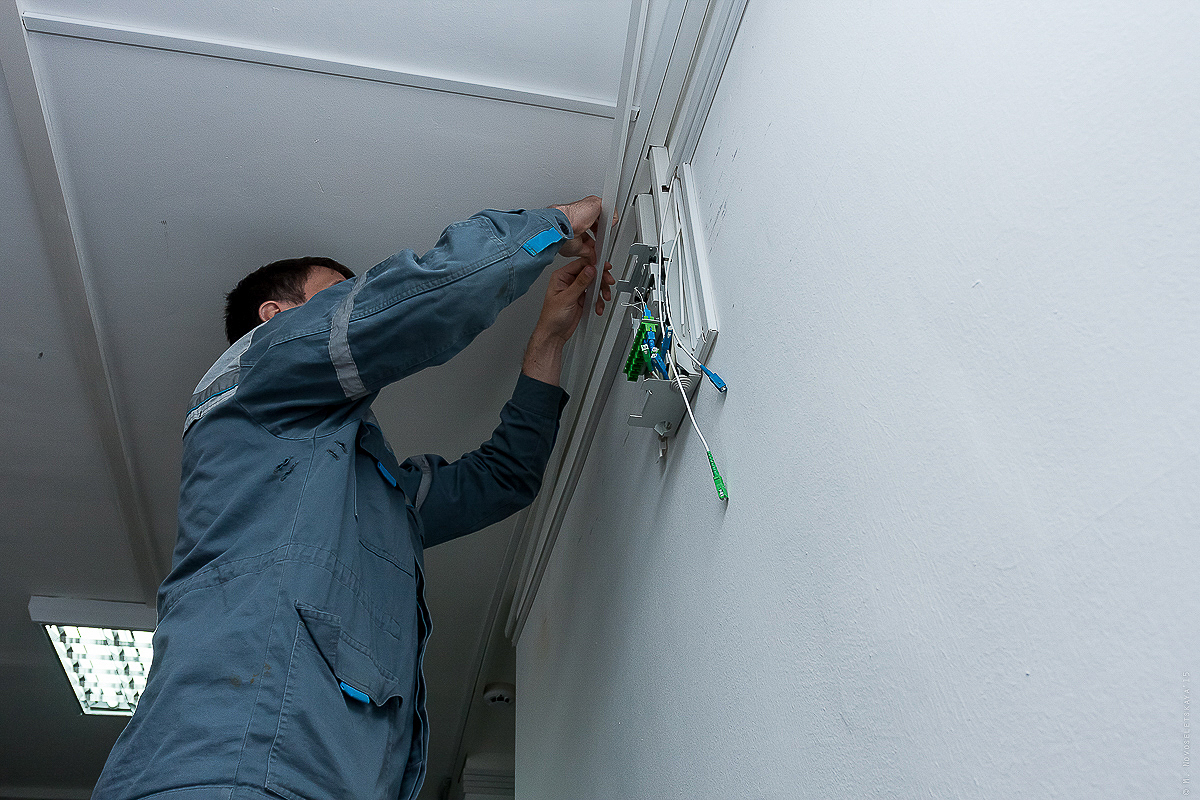
In the same boxes, the cable is pulled directly into the apartment. There, too, the fiber is carefully placed in an optical socket or a pull-out box or cassette of the optical terminal of the bay and closed. According to unwritten rules, the equipment is mounted next to the hole where the optics are pulled in so that the length of the fiber in the apartment is as small as possible. It is better not to lay fiber optics throughout the apartment. Why? It's simple - this thin "wiring" is very, very fragile, sensitive to various bends, kinks, pressure (you don't need to step on it or put furniture, as well as let animals in). From all the above procedures, the optical fiber breaks and often call the master - is it worth your nerves?
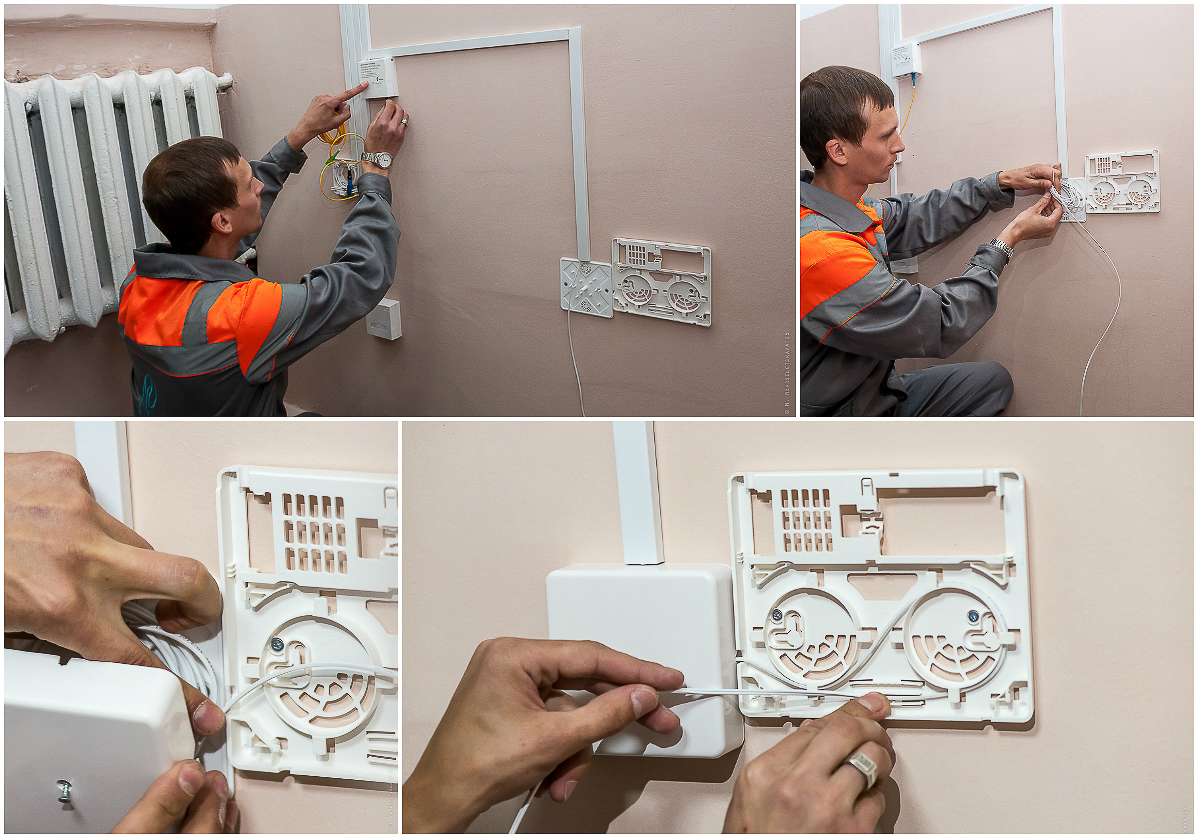
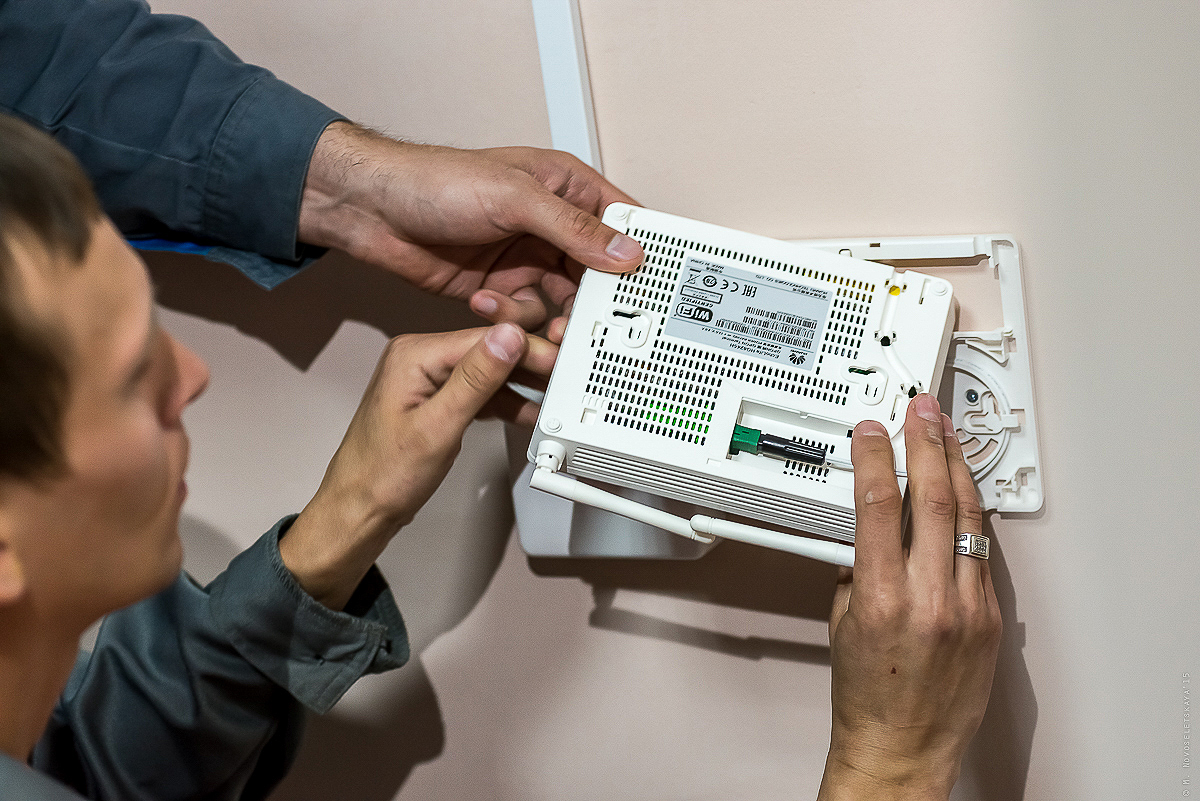
This is how the already delivered equipment in the apartment looks like. Installers are engaged in installation, debugging and connection.

First of all, the employee makes the termination of the optical fiber in the subscriber's apartment and mounts the optical connector. This requires a set of tools: an optical power meter, an optical fiber cleaver, a stripper, Kevlar filament scissors, alcohol lint-free wipes, a visual fault locator and a radiation source, as well as a marker and ruler. To comply with safety regulations, the master usually works in protective glasses.
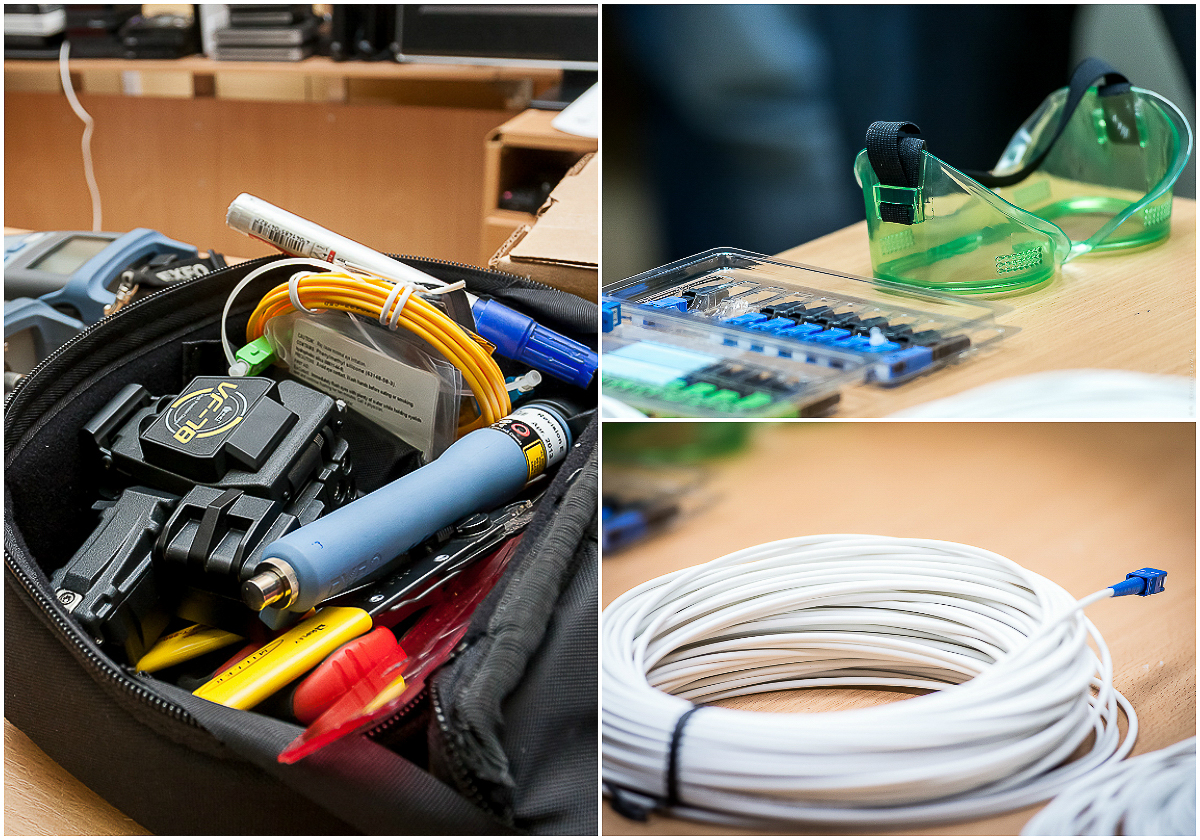
So, the most interesting is ahead. After all, the optical fiber is already in the apartment, but it cannot work yet. To do this, a number of manipulations are carried out. The shank of the optical connector is put on the cable, then a special marked container is taken, where fragments of the optical fiber are placed (which in no case should be left at the consumer's home, they are sharp and dangerous).
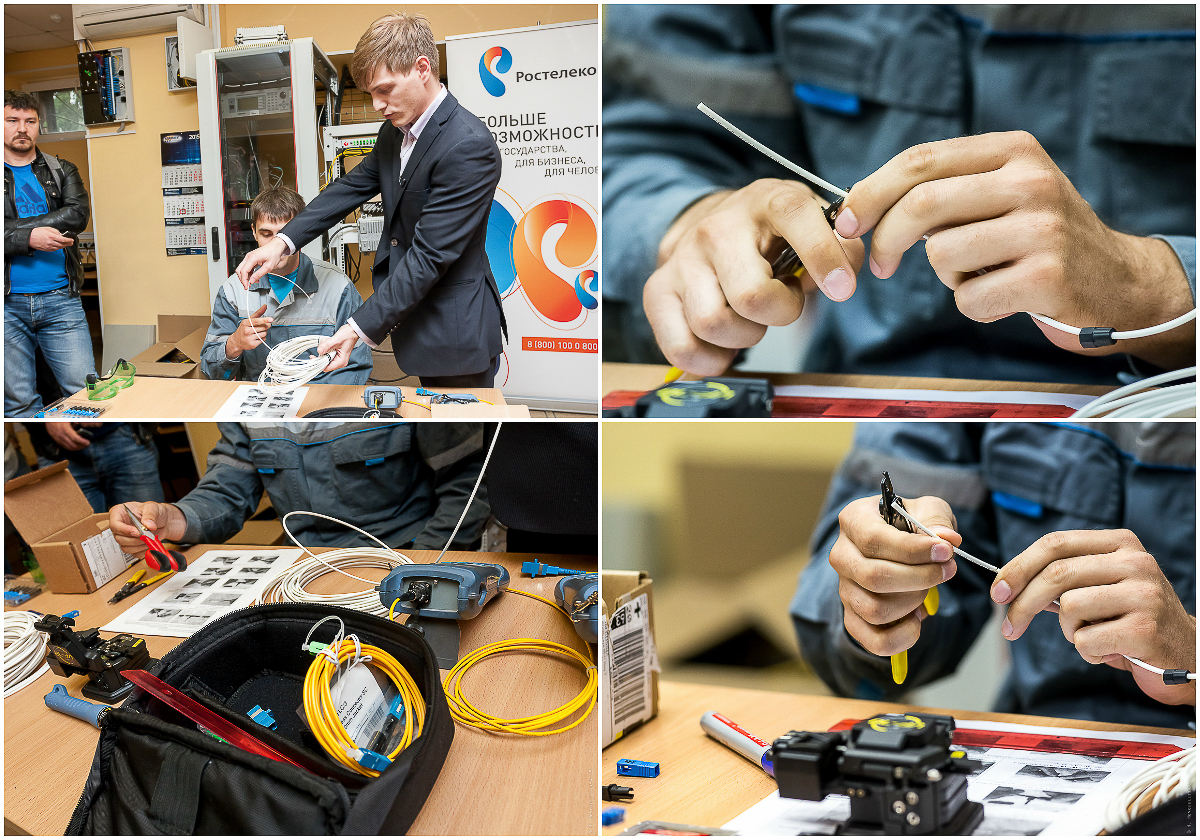
A stripper is taken and the top layer of insulation is removed. Then the marker marks the place to which the fiber will be stripped.
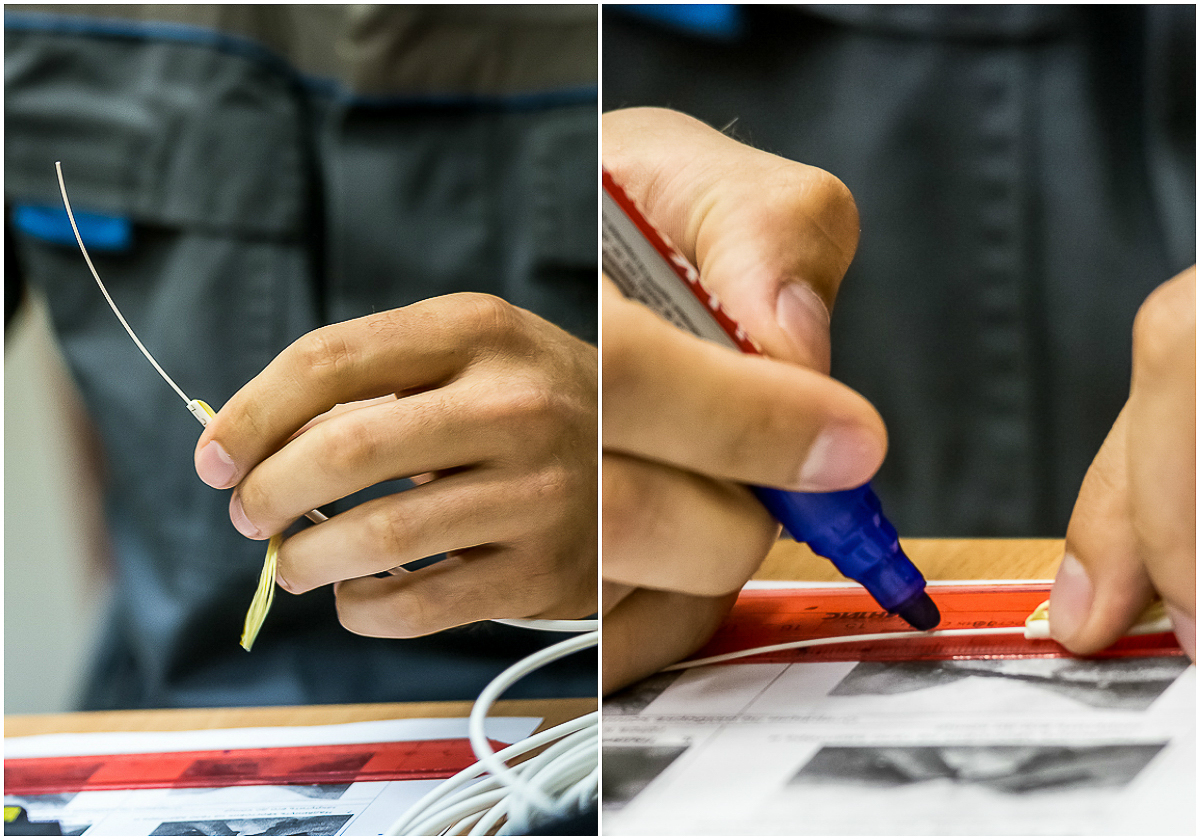
We have a secondary buffer coating of optical fiber and a Kevlar thread.

With a stripper, the secondary coating is carefully incised and removed, and then the primary buffer.
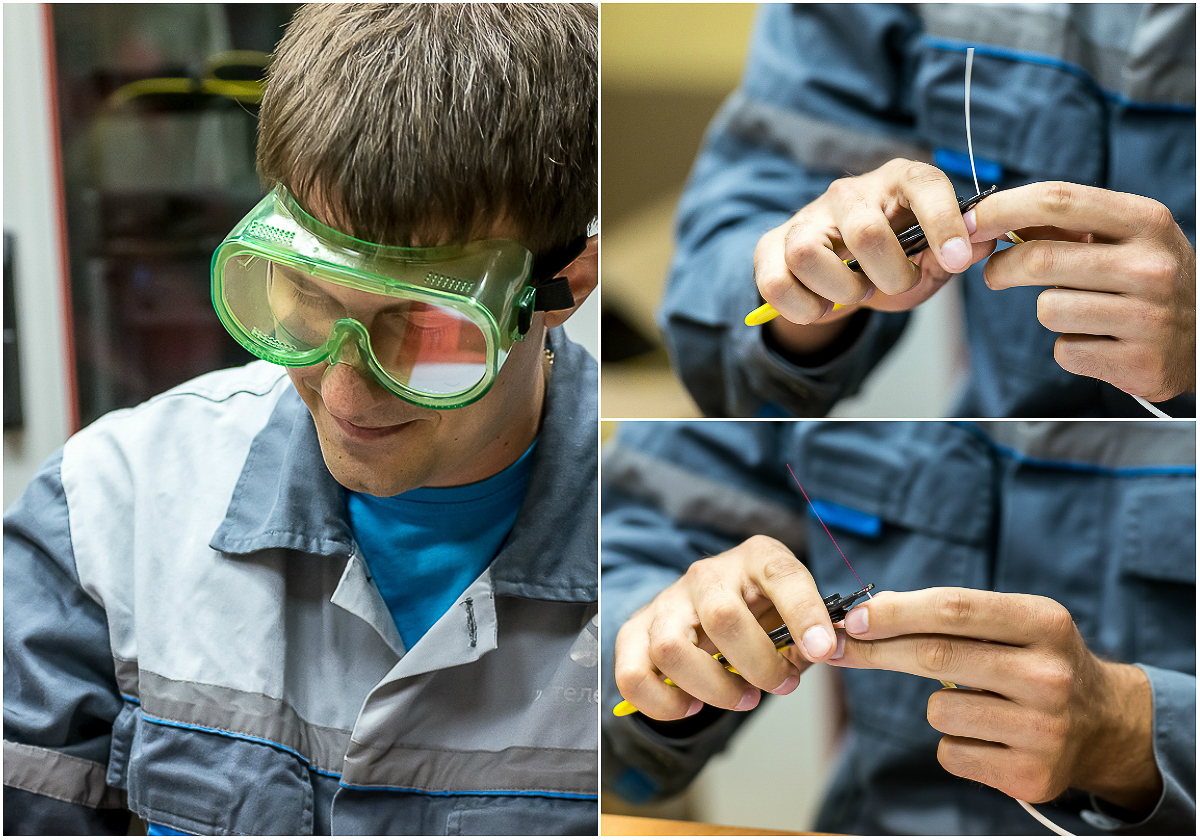
Here it is - a fiber as thin as a hair, which will bring into the house the latest technology, access to the World Wide Web, as well as telephone communications. It's absolutely amazing!

The fiber is cleaned with an alcohol-free lint-free cloth and cleaved on a special device (yes, yes, it's glass in fact!). After that, almost jewelry work takes place - you need to get into the small hole of the connector and fix the fiber there.

Fitting the connector housing
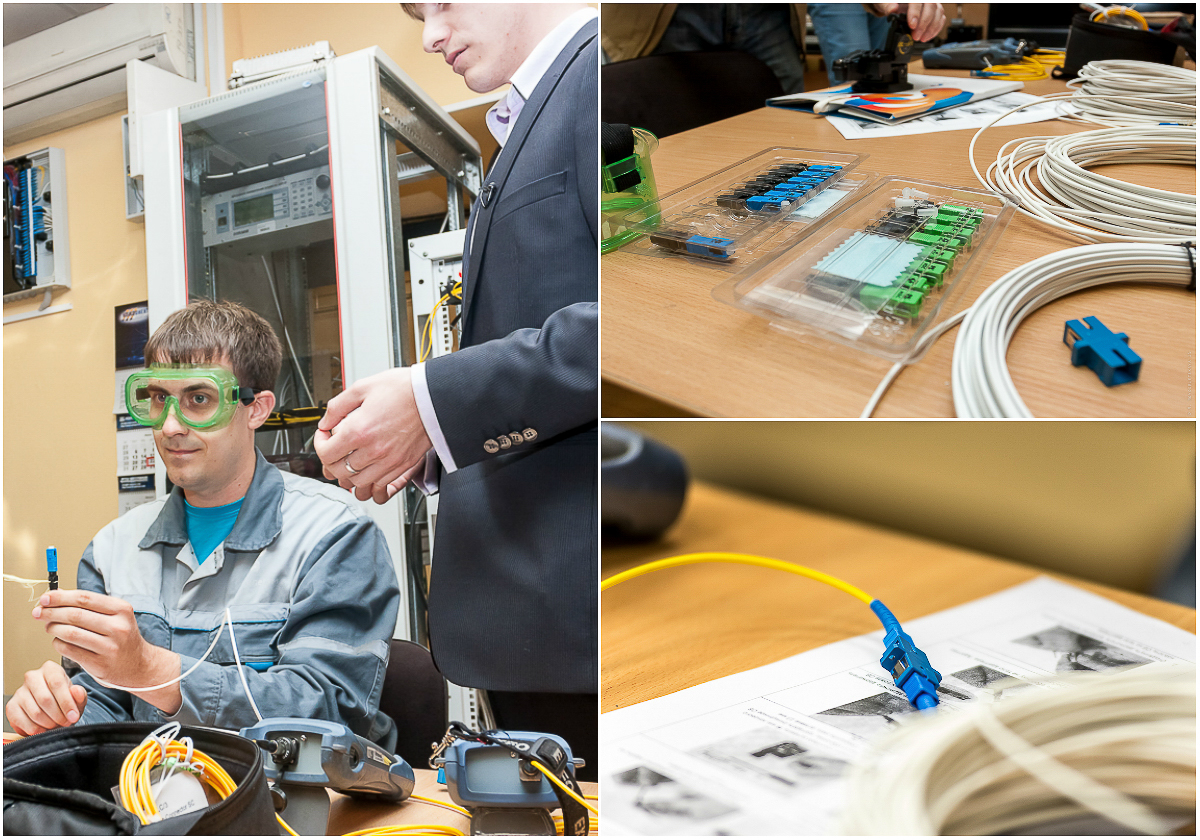

This is where the optical power meter comes into play and the patch cord (signal attenuation level) is measured.
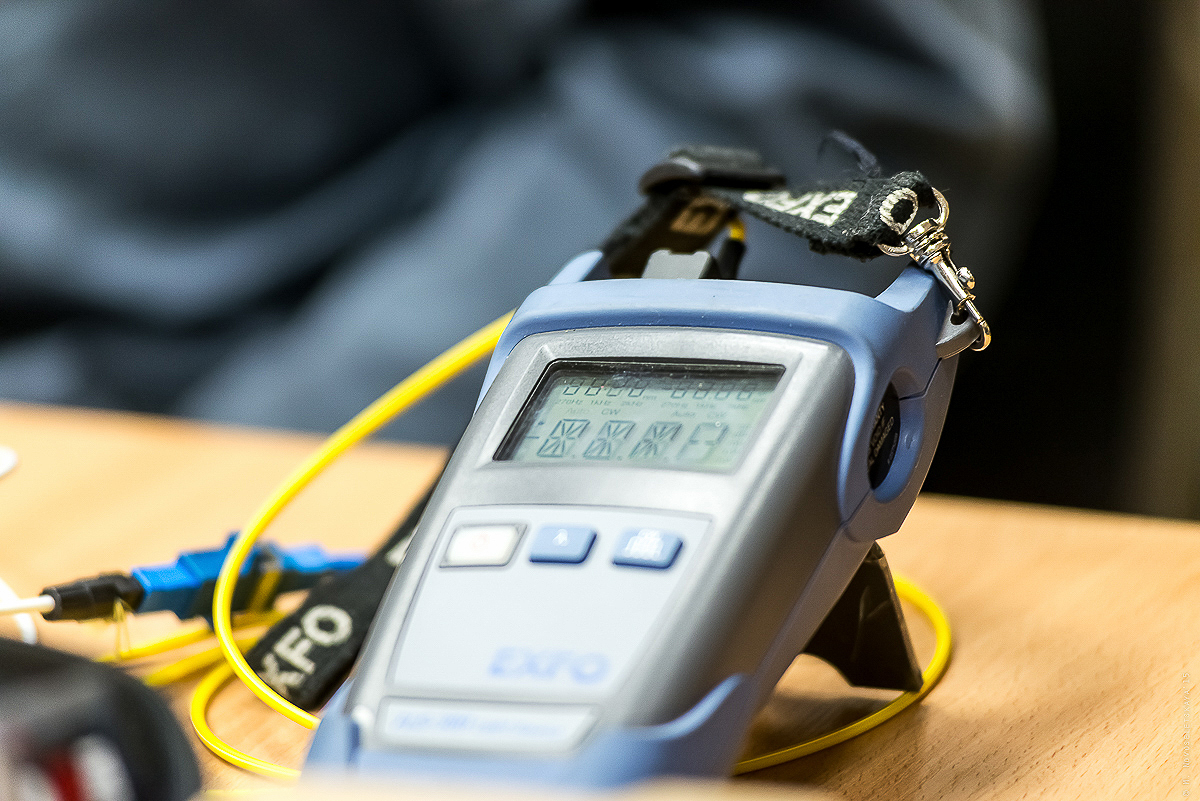
And here is a very interesting device, similar to a large pencil - this is a visual damage locator.
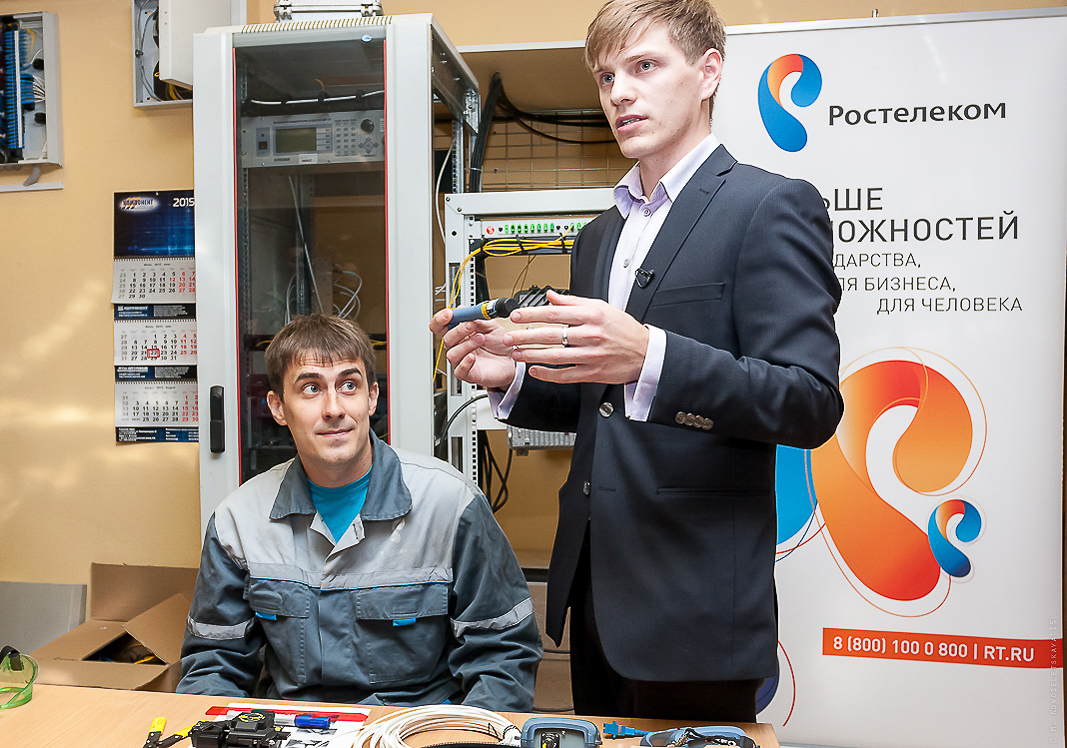
Its purpose is to find damage. A beam of light is directed straight down the fiber and...
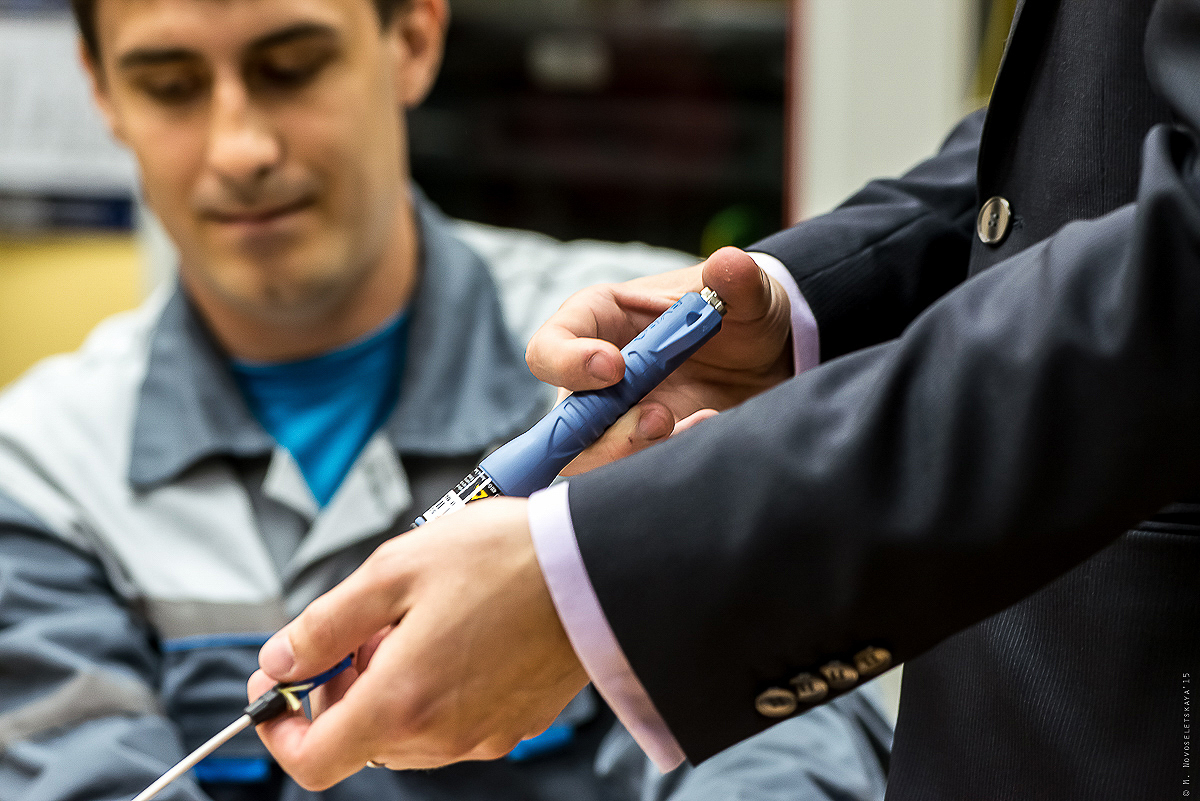
if we find damage, it will be visible visually: the area will glow.

The mounted connector (with cable) is mounted in an optical socket, pull-out box or cassette from which the subscriber's optical terminal will be directly connected. We can say that we have arrived at last step in achieving the coveted PON system in the home.
![]()
For this, a connecting patch cord with different polishing is used. The connecting patch cord is used when installing a socket, when installing a pull box or inserting a cable into the terminal cassette, the cable is immediately terminated with an APC polished connector and a more advanced optical power meter - a universal tester-smartphone on the platform Android. Using it, you can not only make measurements, but also demonstrate to the subscriber the operation of the Wi-Fi service, the operation of the site, etc.
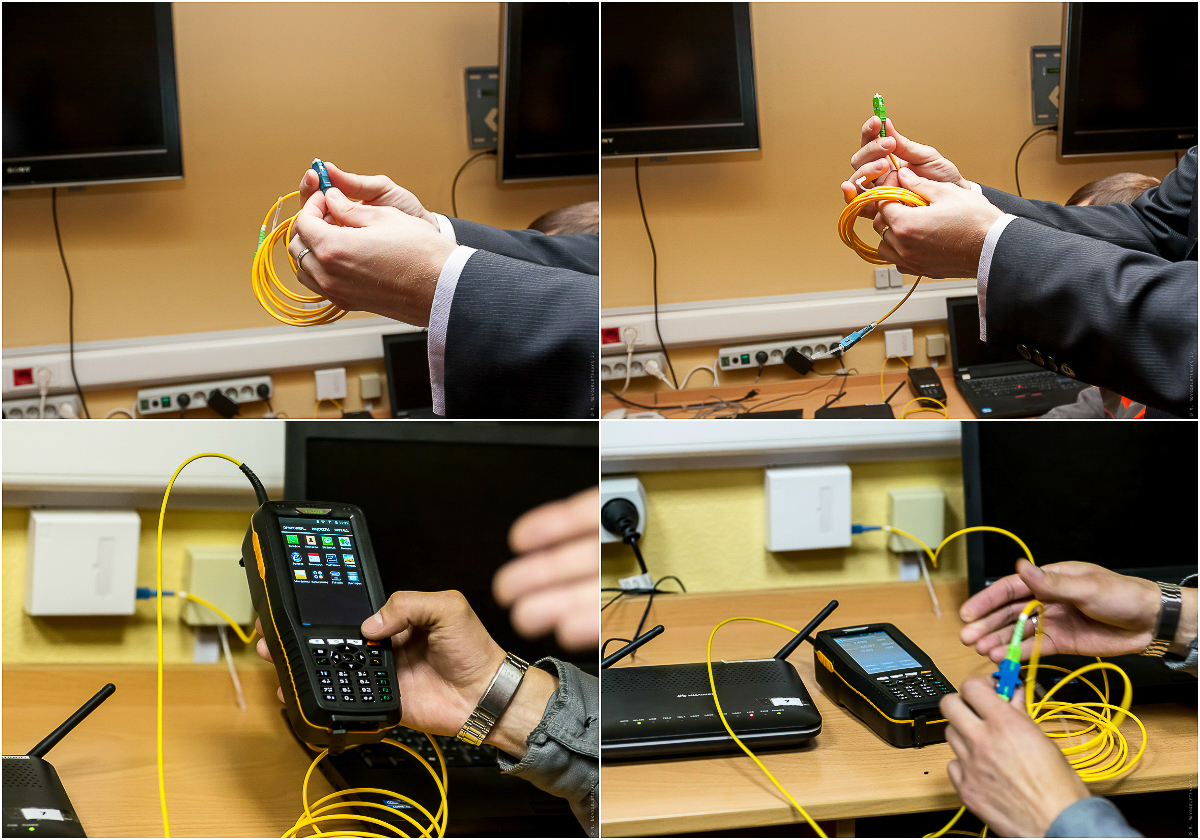
An additional service is being configured - Wi-Fi connection, and access to the network is configured through a test laptop.
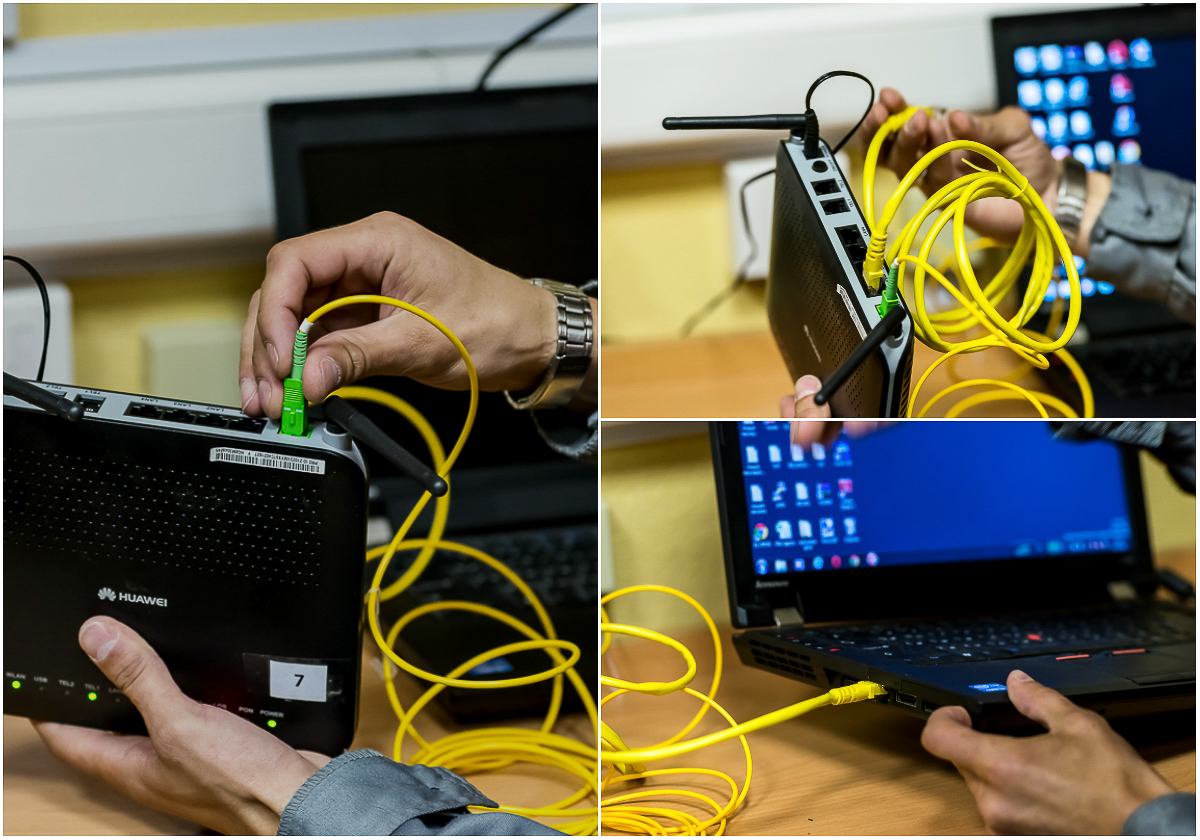
and be sure to show everything to the subscriber!
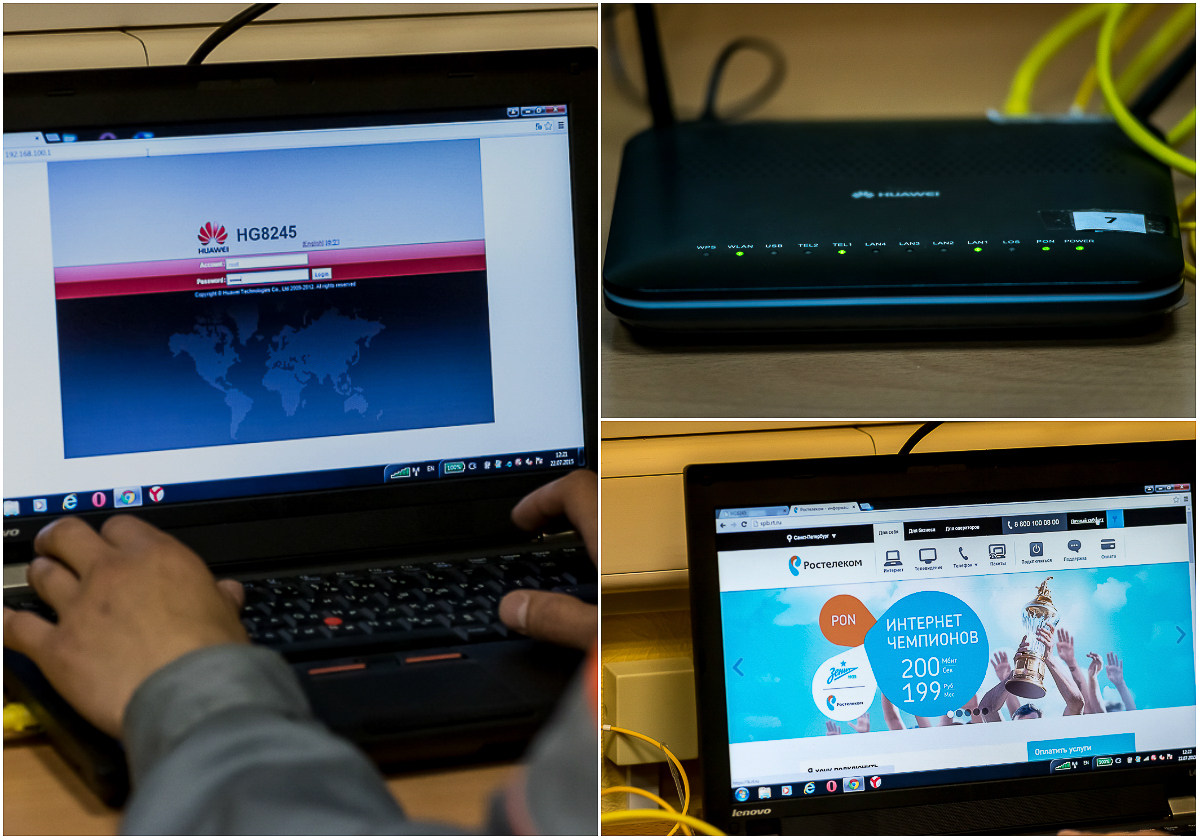
even a test for connection speed and data transfer.

Telephony is connected: it is important to know that only one telephone set is connected to the optical terminal.

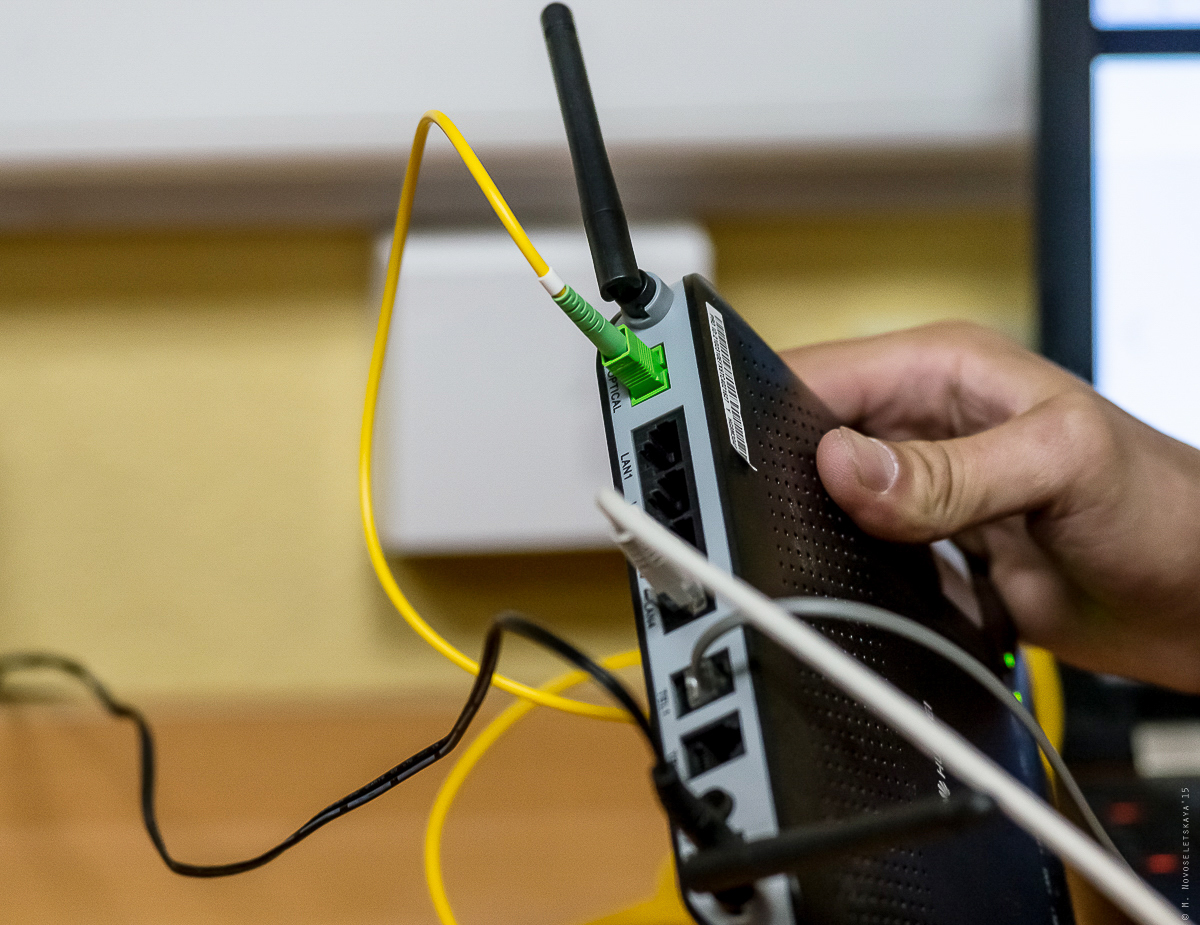
And finally, in this case, the main service of Rostelecom, Interactive Television, is connected. At the first start, the credentials of the set-top box are entered.
And if the installer came to you and did not introduce you to the main functions, you can safely give him a big minus for his work, he must do this without fail.
Separately, the device of the remote control is explained, which can and does duplicate the functions of a stationary remote control (turning on / off the TV, switching the volume), but still is a different device.
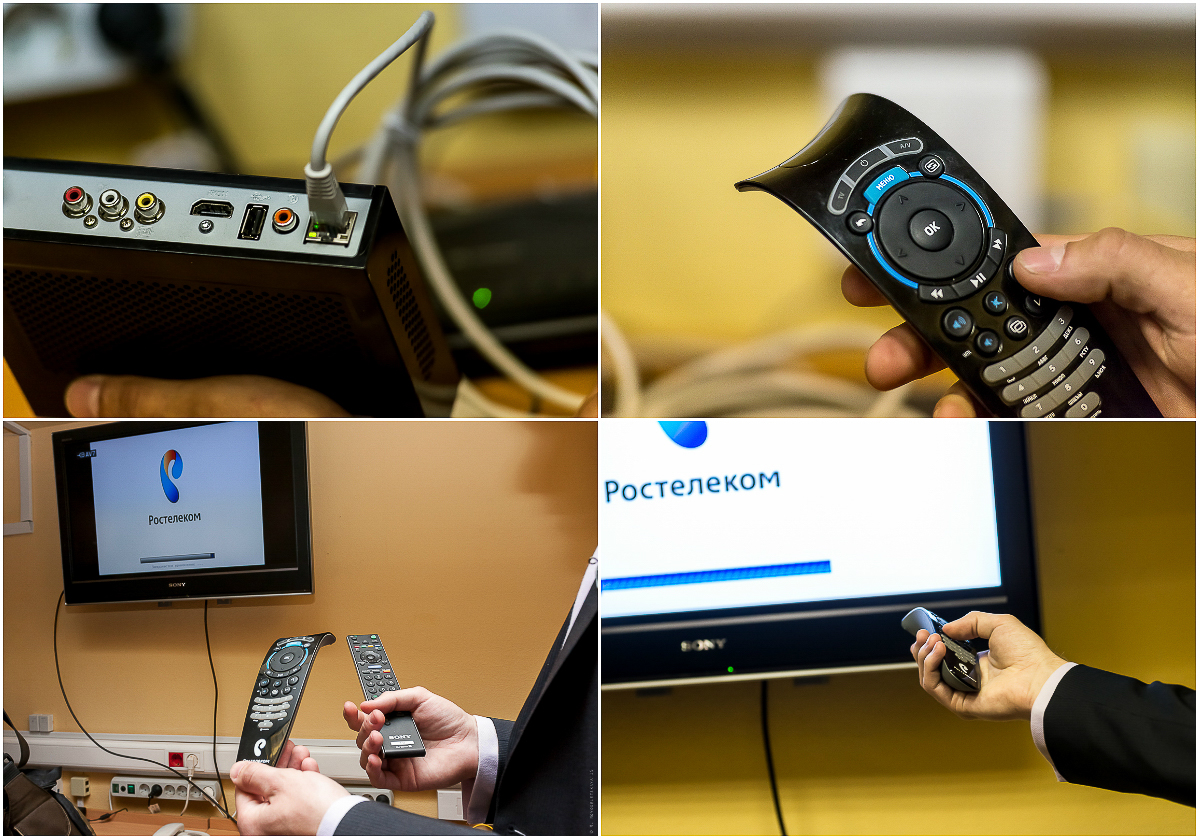
"Interactive TV" functions: creating various profiles, "Multiscreen", "Video rental", viewing photos, videos, music on the screen using the USB input on the set-top box, Internet services (weather, social networks, maps), viewing control (pause, record).
You can connect up to three set-top boxes and, accordingly, up to three TVs to the terminal.
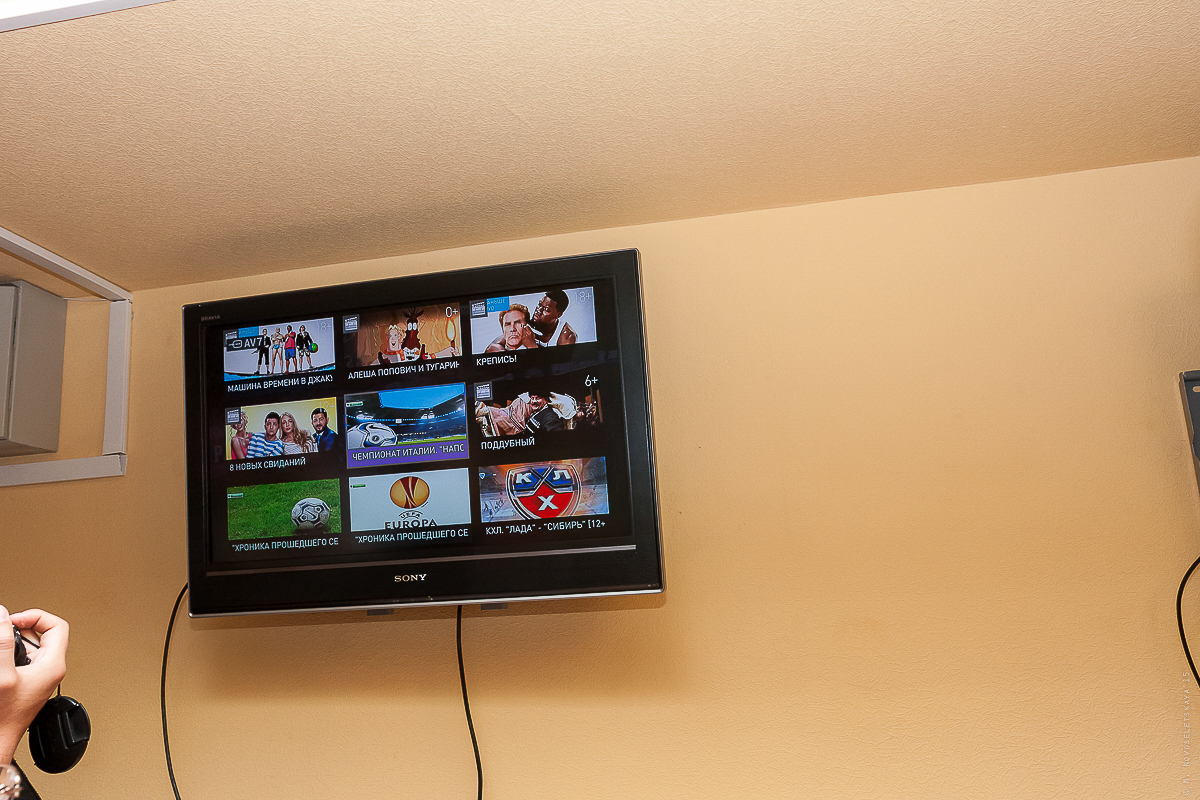
Well, how? Are there any advantages to using PON technology? It seems to me that even the biggest one is the throughput of such a small "hair".
Photos from open sources
Fiber optic cable is a glass bundle of strands that can transmit optical signals. More recently, such a cable began to be used for subscriber lines, and now it is the main medium for transmitting digital information over long distances.
Why do I need an OKG cable?
The JCG cable was developed to replace bulky copper cables. They can be produced in such modifications as single-mode (gained their use in telephony) and multi-mode (widely used in networks). The difference between them is that single-mode fibers can transmit signals with waves of the same length, and multimode fibers can transmit waves with different wavelengths.
Production
It has already been said earlier that WOK is a glass fiber. Initially, one fiber is a glass rod, the diameter of which is from five to eight centimeters. Next, such a rod is loaded into a special machine, which, by melting and pulling, turns it into a fiber. After that, such a fiber is covered with a sheath with internal power components.
FOC is laid in almost the same way as copper, but the difference lies in fragility, i.e. if the wok is excessively bent or stretched, it breaks.
Safety
To work with fiber optic cables, you must never look at the end without special equipment, because. An almost invisible piece of fiber can cause irreparable damage if it gets into your eyes.
Splice
WOCs are spliced either mechanically (thanks to a special device, the ends of the cable are polished, and the gel fills the micro-cavities) or by melting (the fibers melt and become one).
Basically, the fibers are spliced mechanically, because. this requires a simple set of tools that almost all manufacturers offer, and polishing can be done by any support worker. If the fibers are spliced using melting methods, then expensive equipment is needed, and not every installer will be able to do this.
Cable repair
The design of the FOC is perfect from the start and has enough channels in its reserve, which guarantees network operation with losses minimized if the cable is damaged. But at the same time, if damage has occurred, then for repair it will be necessary to make at least 2 additional joints, which can lead to loss of power. In order to prevent this from happening, repair and restoration work should be included in the cable system in advance. Of course, this will require extra money, but it will save you money if there are any problems with the cable.
The choice of cable should be made in accordance with the purposes for which the line is being installed. If you choose a wire for laying a conventional trunk, you can purchase a product with a supporting element made of wire or cable. Such a cable has single-mode fibers, the number of which can start from 16 and end with 48. Also, single-mode wires have a higher coverage area and data transfer distance, which means that when laying the trunk, the total installation cost will be significantly lower than that of multimode. Single-mode cable is usually used for laying telephone networks and cable television.
Multimode cables are capable of transmitting a large amount of data in several waves, which is its main advantage. Such products are used in the construction of cable Internet networks. Multimode fiber will help provide higher data rates than single mode. However, multi-mode wires are far behind in quality and their use is not justified if you want to lay a network whose length exceeds 400 m. Such products are suitable for laying networks over short distances.
Cable characteristics
Having dealt with the type of cable, it is necessary to determine the required characteristics for the cable network. When choosing a product, it is important to pay attention to characteristics such as shock load, which is an indicator of the protection of the wire and its core from impact. Another important parameter is the allowable bend, which indicates the maximum possible radius of curvature of the wire laying. It is important that this indicator be higher if you plan to lay a sewer network, pipeline or cable channel.
Neglecting this parameter can cause damage to the integrity of the wire's optical fibers and cause the product to fail. Another important characteristic of the wire is torsion (the degree of protection of the fiber by the cable sheath) and protection against the ingress of moisture into the cable, which will become important if you use the wire outdoors.
The choice of cable should also be made depending on the place of its use. For example, an optical fiber for a room must have fire protection and not contain a gel, so that when heated, it does not change its structure and subsequently does not spread.
For outdoor use, the presence of armor and a dense layer of fiberglass will be a plus, which will protect the cable from external influences. It is also important that such a cable has a reduced coefficient of friction, as well as internal and external polyethylene protection. Such characteristics are achieved by applying additional materials to the wire.
It was told about the most common types of fiber optic cable used in Ukraine. And today - a cable in a section, and in the course of the story - some practical moments of its installation.
We will not dwell on the detailed structure of all types of cable. Let's take some average typical OK:
- Central (axial) element.
- Optical fiber.
- Plastic modules for optical fibers.
- Film with hydrophobic gel.
- Polyethylene shell.
- Armor.
- Outer polyethylene sheath.
What does each layer represent when viewed in detail?
Central (axial) element
Fiberglass rod with or without polymer sheath. Main purpose - stiffens the cable. Unsheathed fiberglass rods are bad because they break easily when bent and damage the optical fiber located around them.
optical fiber
 Optical fiber strands most often have a thickness of 125 microns (about the size of a hair). They consist of a core (through which, in fact, the signal is transmitted) and a glass shell of a slightly different composition, which ensures complete refraction in the core.
Optical fiber strands most often have a thickness of 125 microns (about the size of a hair). They consist of a core (through which, in fact, the signal is transmitted) and a glass shell of a slightly different composition, which ensures complete refraction in the core.
In cable marking, the diameter of the core and sheath is indicated by numbers through a slash. For example: 9/125 - core 9 microns, shell - 125 microns.
The number of fibers in the cable varies from 2 to 144, this is also fixed by a number in the marking.
Based on the thickness of the core, fiber optics are classified into single mode(thin core) and multimode(larger diameter). Recently, multimode has been used less and less, so we will not dwell on it. We only note that it is intended for use on not long distances. The sheath of multimode cable and patch cords is usually made orange color (single mode - yellow).
In turn, single-mode optical fiber is:
- Standard (marking SF, SM or SMF);
- Dispersion-shifted ( DS, DSF);
- With non-zero shifted variance ( NZ, NZDSF or NZDS).
AT in general terms- fiber-optic cable with a shifted dispersion (including non-zero) is used for much longer distances than a conventional one.
On top of the shell, the glass threads are varnished, and this microscopic layer also plays an important role. Optical fiber without varnish is damaged, crumbles and breaks at the slightest impact. While in lacquer insulation, it can be twisted and subjected to some stress. In practice, fiber optic strands can withstand the weight of the cable on supports for weeks if all other power rods break during operation.
However, you should not place too high hopes on the strength of the fibers - even varnished, they break easily. Therefore, when installing optical networks, especially when repairing existing highways, extreme accuracy is required.
Plastic modules for optical fibers
 These are plastic shells, inside of which there is a bundle of fiber optic filaments and a hydrophobic lubricant. There can be either one such tube with fiber optics in the cable, or several (the latter is more common, especially if there are a lot of fibers). Modules perform the function of protecting fibers from mechanical damage and along the way - their association and marking (if there are several modules in the cable). However, it must be remembered that the plastic module breaks quite easily when bent, and breaks the fibers in it.
These are plastic shells, inside of which there is a bundle of fiber optic filaments and a hydrophobic lubricant. There can be either one such tube with fiber optics in the cable, or several (the latter is more common, especially if there are a lot of fibers). Modules perform the function of protecting fibers from mechanical damage and along the way - their association and marking (if there are several modules in the cable). However, it must be remembered that the plastic module breaks quite easily when bent, and breaks the fibers in it.
Any single standard color marking there are no modules and fibers, but each manufacturer attaches a passport to the cable drum, in which this is indicated.
Film and polyethylene sheath
These are elements of additional protection of fibers and modules from friction, as well as moisture- some types of optical cable contain a hydrophobe under the film. The top film can be additionally reinforced with interweaving threads and impregnated with a hydrophobic gel.
The plastic shell performs the same functions as the film, plus it serves as a layer between the armor and modules. There are cable modifications where it is not available at all.
Armor
 It can be either Kevlar armor (woven threads), or a ring of steel wires, or a sheet of corrugated steel:
It can be either Kevlar armor (woven threads), or a ring of steel wires, or a sheet of corrugated steel:
- Kevlar used in those types of fiber optic cable where the metal content is unacceptable or if you want to reduce its weight.
- Steel wire armored cable designed for underground laying directly into the ground - strong armor protects against many damages, incl. from a shovel.
- Cable with corrugated armor laid in pipes or cable ducts, such armor can only protect against rodents.
Outer polyethylene sheath
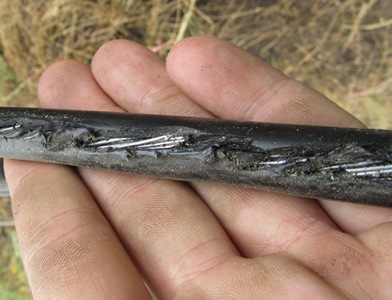 The first and practically the most important level of protection. Dense polyethylene is designed to withstand all the loads that fall on the cable, so if it is damaged, the risk of cable damage increases significantly. You need to make sure that the shell:
The first and practically the most important level of protection. Dense polyethylene is designed to withstand all the loads that fall on the cable, so if it is damaged, the risk of cable damage increases significantly. You need to make sure that the shell:
a) Has not been damaged during installation - otherwise moisture getting inside will increase the losses on the line;
b) Do not touch a tree, wall, corner or edge of a structure, etc. during operation, if there is a risk of friction in this place under wind and other loads.





